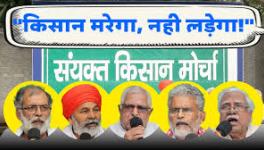Suppression of UNICEF Data to Shield Gujarat
Newsclick interviewed Amit Sengupta of Delhi Science Forum on the "Rapid Survey on Children" below age of 6 years. The survey was done by UNICEF on behalf of UPA-2 Government in 2013-2014 but the data has yet not been made public by the incumbent NDA regime. Amit explains that though the rate of malnutrition has come down by more than 10 % but India is still behind Sub-Sahara African region. In addition to it, Gujarat which was projected as model state by NDA government has higher number of malnourished” children in comparison to the “Bimaru” state like Bihar and M.P. This is one among the major reasons why Modi led NDA government has yet not published this data. Amit explains that the suppression of data is an attempt to hide growing inequality due to pro corporate polices of the current government. He also explained the role of Left Parties in ensuring pro people welfare schemes which are major reason for decline in the malnourishment.

Pranjal: Hello and welcome to Newsclick. A survey was done by UPA government in 2013 and 2014 in collaboration with UNICEF. It was called rapid survey on children below age of 6 years. To discuss the issue with you we have with us Dr. Amit Sengupta from Delhi Science Forum. Hello Amit. This survey was done in 2013 and 14. it was started in 2013-14 by the UPA 2 and UNICEF was doing on it's behalf. So what are the key points of this survey what are the key points of this survey which are still not come out in the public forum.
Amit Sengupta: Actually, if you look at the broad findings of the survey, then it's relatively good news in terms of child nutrition because classically South Asia in particularly, India being the largest country in South Asia has been the worst performing in the world, even worst than Sub-Saharan Africa which is seen as the poorest region in the world in terms of child nutrition and we have typically had sort of rates of Mal-nourishment shown by underweight children around 50 percent. So the NHFS, the family health survey in 2005 put the figure at about 43 percent. So the recent survey which UNICEF did on the behalf of the government which spans a period of 2013 and 14 shows that it has come down the level of mal-nourishment, incidence of mal-nourishment has come down to just under 30 percent. Also the rates of stunting have come down significantly from 48 percent to around 39 percent. So overall this is good news but the caveat that one has to also sort of keep in mind is that this still means India is doing worst than sub-Saharan Africa even today. So a long way to go but overall this is good news.
Pranjal: This report is still not in the Public Forum. What are reasons why this report has not been made officially declared by the government of India.
Amit: This is a very strange story and of course because the government has not made clear why they have been sitting on this report for over a year now. It is understood that the report was available just around the time when government changed hands and at least in it's present form, in it's finished form it was available around October 2014. So one would have expected given that the report does indicate significant progress in tackling child ma-nutrition. You have to keep in mind the fact that there was almost a total stagnation in the last two decades in terms of progress on tackling child mal-nutrition. That the government would be interested in making these reports public which brings to mind various conspiracy theories which have been doing the rounds. But one of the theories that have been doing the round which seems plausible is that if you look at the disaggregated data. So the data in this report is available in the national level as well as the state level. If you look at the disaggregated data, then significantly Gujarat is doing much worse than almost all other states and Gujarat's performance is on par or even worse than some of the states in what is known as the BIMARU region which are classically known as the more under-developed regions of India. Now, that is very very significant for two reasons. One is that if you look at the GNP per capita then Gujarat is one of the wealthier states, one of the largest states one of the wealthiest states in India and we hear a lot about about entrepreneurship in Gujarat about how state level policies in Gujarat has actually contributed to a rise in incomes in Gujarat etc. Now clearly what this survey is showing is that apparent increase in wealth has been at the expense of a growing inequity and this is also significant in the context of the so called Gujarat model of development that the present government has been sort of putting forward as it's model for it's entire country. The fact that the Gujarat model seems to be fairly empty and particularly severe on the people who are poor and who are from the marginalized communities etc. So that is one of the theories doing the round so why this has been suppressed. But in the absence of any other indications from the government it is all speculation at the moment.
Pranjal: Also, when you talk about stratification of society there is no data which is available on the religious lines. But if you look at the social stratification on the basis of caste and just say like for schedule castes the 42.4 is the stunted and 42.3 for the scheduled tribes. If you look at the national budget of this current NDA government, they have cut down on tribal sub plan also and the plan for scheduled caste also. Do you find the link between the process of pro-corporate policies that this government has been making?
Amit: Yes, that is of course one part of it. In fact, the proclivity of the present government to cut savage cuts in expenditures on welfare measures can also be a motivation for keeping a report like this, suppressing a report like this because questions would be really asked if this report was made public and I am sure it will now had to be made public because it is now more or less in the public domain even though the government has not released it. The questions will be asked as to what are the reasons? Why we seem to have made some progress not enough many people would say, some progress in tackling mal-nourishment and you can probably sort of look at some plausible reasons why this is happened. Much of these are related to the policies in the UPA-1 government which again were driven to a very large extent by the pressures from the Left. So you had for example the employment guarantee act, you had the national rural health mission, you had a push for a food security act. No, we didn't get a perfect food security act, no where nearer perfect one but we did progress in that direction. Also greater outlays on the programmes ICDS, child development scheme, Aanganwadi schemes etc. So there was this push for in spite... So the UPA1 and two were both neo-liberal in their outlook. But there was popular pressure and at least in UPA1 pressure from within to an extent by the left parties. Now, that was the momentum for the last two terms of the government one decade long which plausibly one can say contributed to the decrease in the rates of mal-nourishment because mal-nourishment is actually a very good indicator of inequity and the fact that in spite of neo-liberal policies we seem to have done quite well is an indicator that these policies were working to an extent. Now, having decided to scrap more or less all those policies the present government would be very uncomfortable in then being questioned if something was working earlier why are you scrapping them. Why have you done away with a slew of welfare measures that were initiated in the last one decade which doesn't mean that what UPA government did was anywhere near enough.
Pranjal: When you talk about welfare schemes, even the ICDS budget was cut nearly by 50 percent form 16000 crores to 8000 crores and the recent survey by the NSSO on the health. So if you look at the expenditure even in the public sector it is 6000 per individual and private 26000 per individual. While there is no adequate facility available to support this sort of public welfare systems the health conditions and all that. So what do you think is the way ahead if you look at the current regime in power?
Amit: See as I said earlier, this is the most blatant aggressive right wing neo-liberal regime that India has ever. We had a fairly detailed neo-liberal in place since the early 90s in India. But it has never been so aggressive and so blatant to the exclusion of all countervailing attempts to somehow mitigate the impact of neo-liberal economic policies. I do not see any signs in this government of even tempering it's initial enthusiasm of pushing forward neo-liberal reforms and in fact, I would say suppression of this report is an indicator that it is going to brazen this out, that it is going to suppress all evidence which speaks to the contrary, which speaks to the necessity to mitigate the impact of neo-liberalism on the poor and the indigent. So I don't as far as this government is concerned I have very few hopes and this is I mean what we are discussing is one more example of not only their willingness but their aggressive design to push forward the reforms at the cost of the lives of the millions of people of this country.
Pranjal: That's all the time we have today and as the things proceed we will be coming back to you on such issues. Thank you for giving us your time. Thank you for watching Newsclick.
Get the latest reports & analysis with people's perspective on Protests, movements & deep analytical videos, discussions of the current affairs in your Telegram app. Subscribe to NewsClick's Telegram channel & get Real-Time updates on stories, as they get published on our website.
























